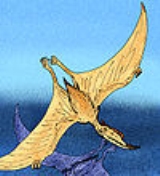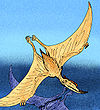
Dsungaripterus
Encyclopedia
Dsungaripterus was a genus
of pterosaur
, with an average wingspan of 3 metres (9.8 ft). It lived during the Early Cretaceous
, in China, where the first fossil was found in the Junggar Basin.

 Dsungaripterus was in 1964 named by Yang Zhongjian
Dsungaripterus was in 1964 named by Yang Zhongjian
. The genus name combines a reference to the Junggar Basin with a Latinized Greek pteron, "wing". The type species
is Dsungaripterus weii, the specific name honouring paleontologist C.M. Wei of the Palaeontological Division, Institute of Science, Bureau of Petroleum of Sinkiang. The holotype
is IVPP No. V-2776, a partial skull and skeleton. From 1973 more material has been found including almost complete skulls.
In 1980 Peter Galton
renamed Pterodactylus brancai (Reck 1931), a form from a late Jurassic African formation, into Dsungaripterus brancai, but the identification is now commonly rejected. In 1982 Natasha Bakhurina named a Dsungaripterus parvus based on a smaller skeleton from Mongolia
. Later this was renamed into "Phobetor", a preoccupied name, and in 2009 concluded to be identical to Noripterus
. In 2002 a Dsungaripterus wing finger phalanx was reported from Korea
.
Genus
In biology, a genus is a low-level taxonomic rank used in the biological classification of living and fossil organisms, which is an example of definition by genus and differentia...
of pterosaur
Pterosaur
Pterosaurs were flying reptiles of the clade or order Pterosauria. They existed from the late Triassic to the end of the Cretaceous Period . Pterosaurs are the earliest vertebrates known to have evolved powered flight...
, with an average wingspan of 3 metres (9.8 ft). It lived during the Early Cretaceous
Early Cretaceous
The Early Cretaceous or the Lower Cretaceous , is the earlier or lower of the two major divisions of the Cretaceous...
, in China, where the first fossil was found in the Junggar Basin.
Discovery and species


Yang Zhongjian
Yang Zhongjian , courtesy name Keqiang , also known as C.C. Young, was one of China's foremost paleontologists. He has been called the 'Father of Chinese vertebrate paleontology'...
. The genus name combines a reference to the Junggar Basin with a Latinized Greek pteron, "wing". The type species
Type species
In biological nomenclature, a type species is both a concept and a practical system which is used in the classification and nomenclature of animals and plants. The value of a "type species" lies in the fact that it makes clear what is meant by a particular genus name. A type species is the species...
is Dsungaripterus weii, the specific name honouring paleontologist C.M. Wei of the Palaeontological Division, Institute of Science, Bureau of Petroleum of Sinkiang. The holotype
Holotype
A holotype is a single physical example of an organism, known to have been used when the species was formally described. It is either the single such physical example or one of several such, but explicitly designated as the holotype...
is IVPP No. V-2776, a partial skull and skeleton. From 1973 more material has been found including almost complete skulls.
In 1980 Peter Galton
Peter Galton
Peter M. Galton is a British vertebrate paleontologist working in America, who has to date written or co-written about a hundred papers in scientific journals or chapters in paleontology textbooks, especially on ornithischian and prosauropod dinosaurs.With Robert Bakker in a joint article...
renamed Pterodactylus brancai (Reck 1931), a form from a late Jurassic African formation, into Dsungaripterus brancai, but the identification is now commonly rejected. In 1982 Natasha Bakhurina named a Dsungaripterus parvus based on a smaller skeleton from Mongolia
Mongolia
Mongolia is a landlocked country in East and Central Asia. It is bordered by Russia to the north and China to the south, east and west. Although Mongolia does not share a border with Kazakhstan, its western-most point is only from Kazakhstan's eastern tip. Ulan Bator, the capital and largest...
. Later this was renamed into "Phobetor", a preoccupied name, and in 2009 concluded to be identical to Noripterus
Noripterus
Noripterus is a genus of dsungaripterid pterodactyloid pterosaur from Lower Cretaceous-age Lianmuqin Formation in the Junggar Basin of Xinjiang, China. It was first named by Yang Zhongjian in 1973...
. In 2002 a Dsungaripterus wing finger phalanx was reported from Korea
Korea
Korea ) is an East Asian geographic region that is currently divided into two separate sovereign states — North Korea and South Korea. Located on the Korean Peninsula, Korea is bordered by the People's Republic of China to the northwest, Russia to the northeast, and is separated from Japan to the...
.

